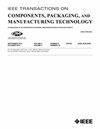Fabrication-Induced Warpage Characterization Analysis of Micro-LED Fan-Out Packaging
IF 2.3
3区 工程技术
Q2 ENGINEERING, ELECTRICAL & ELECTRONIC
IEEE Transactions on Components, Packaging and Manufacturing Technology
Pub Date : 2025-02-03
DOI:10.1109/TCPMT.2025.3538039
引用次数: 0
Abstract
The advancement of light-emitting diode (LED) packaging technology has been driven by the increasing demand for high-performing and compact lighting solutions. Traditional packaging methods, such as chip-on-board technology and surface-mount technology, face challenges in meeting the demands for high input/output density and effective thermal management. This scenario has led to the adoption of advanced packaging technologies, including wafer-level packaging (WLP) and fan-out (FO) technology, which offer advantages such as improved surface flatness, reduced dielectric loss, and cost-effectiveness. This study presents a novel FO-LED architecture with a redistribution layer (RDL)-first design to achieve high density and thin form factors. A 3-D finite element analysis (FEA) model that incorporates equivalent material properties for the RDL and Cu pillar bumps is developed to analyze the warpage behavior induced during the FO-LED assembly fabrication process. The model’s validity is confirmed by comparing simulation results with experimental measurements obtained at various stages of FO-LED fabrication. A parametric study is conducted to evaluate the impact of four control factors—Young’s modulus of polyimide (PI), coefficient of thermal expansion (CTE) of PI, RDL thickness, and curing temperature—on warpage performance. The findings highlight that the warpage in the FO-LED is significantly affected by the CTE mismatch between the RDL, the LED, and the silicon substrate, with the properties of the PI material playing a crucial role. These insights offer valuable guidance for the design and optimization of robust FO-LED packages.微型 LED 扇出封装的制造诱发翘曲特性分析
本文章由计算机程序翻译,如有差异,请以英文原文为准。
求助全文
约1分钟内获得全文
求助全文
来源期刊

IEEE Transactions on Components, Packaging and Manufacturing Technology
ENGINEERING, MANUFACTURING-ENGINEERING, ELECTRICAL & ELECTRONIC
CiteScore
4.70
自引率
13.60%
发文量
203
审稿时长
3 months
期刊介绍:
IEEE Transactions on Components, Packaging, and Manufacturing Technology publishes research and application articles on modeling, design, building blocks, technical infrastructure, and analysis underpinning electronic, photonic and MEMS packaging, in addition to new developments in passive components, electrical contacts and connectors, thermal management, and device reliability; as well as the manufacture of electronics parts and assemblies, with broad coverage of design, factory modeling, assembly methods, quality, product robustness, and design-for-environment.
 求助内容:
求助内容: 应助结果提醒方式:
应助结果提醒方式:


